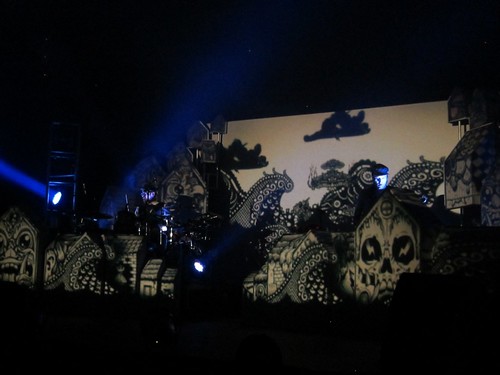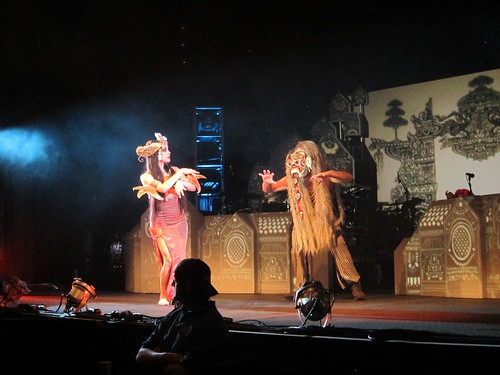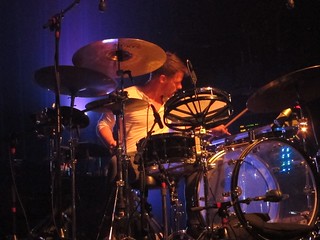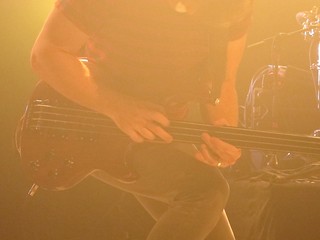Unscripted reflection
When I was a kid, I loved to go to the natural science museum and look at the dinosaurs. There was something cool about seeing the articulated skeletal fossils next to artists' renditions of how they might have appeared in life. It was a while before I realized that those sketches were basically just guesswork, but that epiphany opened up possibilities in my mind as I imagined alternatives to what had been put before me. Even now, I prefernot to have everything all spelled out. The best books, movies, or music leave a bit of mystery that pushes some of the work onto the audience.
That's exactly why Martin Gore's new single, "Europa Hymn" is so enjoyable, It's more like a gesture drawing than a fully developed song. Even though it's barely more than three minutes, Gore takes his time to place a small set of elements -- synthesizer swells and electronic beats -- and he lets them just reverberate within the sonic space. The track is moody and reflective, but the sparse arrangement doesn't provide much additional narrative direction. It rises from the synthesizer waves, builds up some rhythm to suggest a kind of down-tempo electro-pop, and then sinks back under the lonely surface, leaving room for a world of interpretations: it could represent the arc of a relationship, the ebb and flow of life, or even the sense of a sculptor finding the shape that hides within a block of marble.
Gore is best known as one of the founding members of Depeche Mode, and it's easy to hear the connection between this and his band work. But while the palette is familiar, this song distills synth-pop down to its electronic essence, discarding the urgency and tension to focus on an ethereal sense Zen purity, where the listener project their own meaning.
"Europa Hymn" is one of 16 tracks from Gore's new album, MG, which came out at the end of last month.
When I was a kid, I loved to go to the natural science museum and look at the dinosaurs. There was something cool about seeing the articulated skeletal fossils next to artists' renditions of how they might have appeared in life. It was a while before I realized that those sketches were basically just guesswork, but that epiphany opened up possibilities in my mind as I imagined alternatives to what had been put before me. Even now, I prefernot to have everything all spelled out. The best books, movies, or music leave a bit of mystery that pushes some of the work onto the audience.
That's exactly why Martin Gore's new single, "Europa Hymn" is so enjoyable, It's more like a gesture drawing than a fully developed song. Even though it's barely more than three minutes, Gore takes his time to place a small set of elements -- synthesizer swells and electronic beats -- and he lets them just reverberate within the sonic space. The track is moody and reflective, but the sparse arrangement doesn't provide much additional narrative direction. It rises from the synthesizer waves, builds up some rhythm to suggest a kind of down-tempo electro-pop, and then sinks back under the lonely surface, leaving room for a world of interpretations: it could represent the arc of a relationship, the ebb and flow of life, or even the sense of a sculptor finding the shape that hides within a block of marble.
Gore is best known as one of the founding members of Depeche Mode, and it's easy to hear the connection between this and his band work. But while the palette is familiar, this song distills synth-pop down to its electronic essence, discarding the urgency and tension to focus on an ethereal sense Zen purity, where the listener project their own meaning.
"Europa Hymn" is one of 16 tracks from Gore's new album, MG, which came out at the end of last month.


 World music -- that vague catch-all label -- largely falls into two flavors, neither of which reflect too well on the Westerners who coined the term. The bulk of it is “delightfully exotic” or “strange but cool”, showcasing some culture’s musical heritage, but repackaged in easy to digest servings to appeal to the jaded palate. Worse than that are the half breed mutants that hover between appropriation and cargo-cult aspiration, sometimes with rock artists harnessing foreign musicians without understanding their cultural context, other times with those musicians trying with mild success to emulate Western pop. Even so, I’ll confess that I’ve enjoyed my share of all of these, sometimes with a frisson of guilt.
World music -- that vague catch-all label -- largely falls into two flavors, neither of which reflect too well on the Westerners who coined the term. The bulk of it is “delightfully exotic” or “strange but cool”, showcasing some culture’s musical heritage, but repackaged in easy to digest servings to appeal to the jaded palate. Worse than that are the half breed mutants that hover between appropriation and cargo-cult aspiration, sometimes with rock artists harnessing foreign musicians without understanding their cultural context, other times with those musicians trying with mild success to emulate Western pop. Even so, I’ll confess that I’ve enjoyed my share of all of these, sometimes with a frisson of guilt.


 Go ahead, judge
Go ahead, judge  If there was ever a band to demonstrate that labels are meaningless, it would be the long-lived but under-the-radar band
If there was ever a band to demonstrate that labels are meaningless, it would be the long-lived but under-the-radar band  Anyone who knows
Anyone who knows 








 Sometimes, it seems like hip hop has become a kind of musical cilantro or bacon. It’s the hipster ingredient to add to any tired or bland project to give it a spark of relevance. Mashed up the other way, pairing a rap delivery with an unexpected backing track (Classical! Country!), the juxtaposition usually serves as an ironic in-joke. It’s not really even clever anymore, and I’ve gotten tired of strained cross-breeding that tries to pass itself off as creativity. Which brings us to
Sometimes, it seems like hip hop has become a kind of musical cilantro or bacon. It’s the hipster ingredient to add to any tired or bland project to give it a spark of relevance. Mashed up the other way, pairing a rap delivery with an unexpected backing track (Classical! Country!), the juxtaposition usually serves as an ironic in-joke. It’s not really even clever anymore, and I’ve gotten tired of strained cross-breeding that tries to pass itself off as creativity. Which brings us to  It all begins with an organic splash of guitar, wrapped in a light haze of feedback. Anticipation continues to build as
It all begins with an organic splash of guitar, wrapped in a light haze of feedback. Anticipation continues to build as 







 No matter where you go, there you are. Temporary distractions and denial eventually bow to the truth and the truth is not pretty. Over the last two and a half decades, Trent Reznor used
No matter where you go, there you are. Temporary distractions and denial eventually bow to the truth and the truth is not pretty. Over the last two and a half decades, Trent Reznor used  The octopus has many arms and sometimes, the left, er.. tentacle can’t quite guess what the others are up to. Rather than settle for a definable sound,
The octopus has many arms and sometimes, the left, er.. tentacle can’t quite guess what the others are up to. Rather than settle for a definable sound, 

 Blue Lines was a seed crystal dropped into a super-saturated British music scene back in 1991. A new band with the unlikely name of
Blue Lines was a seed crystal dropped into a super-saturated British music scene back in 1991. A new band with the unlikely name of  Imagine an alternate reality where Factory Records didn’t implode in 1992 but instead carried their trademark sound forward to the present day, a timeline where the darkwave sounds of Joy Division, New Order and Bauhaus matured and incorporated modern electronic music.
Imagine an alternate reality where Factory Records didn’t implode in 1992 but instead carried their trademark sound forward to the present day, a timeline where the darkwave sounds of Joy Division, New Order and Bauhaus matured and incorporated modern electronic music.